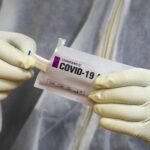Researchers are looking for ways to prevent paediatric radiation-induced high-grade gliomas (RIGs) from developing, as well as ways to treat them once they develop. It is a type of brain tumour caused by cranial radiation therapy used to treat other cancers, most commonly brain cancers. The study’s findings were published in the journal ‘Nature Communications.’RIGs are responsible for nearly 4% of all childhood brain tumour deaths, but there have been few studies on RIGs and how to treat them. As a paediatric oncologist, Adam Green, MD, sees some of the most heartbreaking cases: children who beat cancer only to have an incurable brain tumour appear five years later.”
It’s especially tragic because, by this point, they’re generally teenagers or young adults trying to move on with their lives after dealing with cancer and may still be dealing with some of the aftereffects of the treatments,” said Green, a CU Cancer Center member who practises at Children’s Hospital Colorado.
“Then, all of a sudden, they develop an incurable secondary tumour, and the majority of them die within a year. It’s truly dreadful “Green elaborated.Green and graduate student John DeSisto spent the past four years analysing RIGs using DNA and RNA sequencing from patient samples collected over the past decade by the Morgan Adams Foundation Pediatric Brain Tumor Research Program at the University of Colorado School of Medicine. Green and his colleagues, which included members of the CU Cancer Center as well as scientists from St Jude Children’s Research Hospital in Memphis and the Children’s Cancer Center in Hamburg, Germany, were looking for ways to prevent RIGs from forming as well as ways to treat them once they did.”We discovered that the mutations found in these tumours are very different from the mutations found in de novo paediatric high-grade gliomas.

It appears that these are being driven to develop by a different biological process “Green stated. Green and his colleagues examined more than 30 tumour samples using RNA sequencing, eventually dividing them into two subgroups based on which genes were turned off and on in the samples.
One of the subgroups had a reduced ability to repair DNA, prompting the researchers to speculate that patients with conditions that cause impaired DNA repair may be more likely to develop RIGs after being exposed to radiation. If those specific flaws can be identified early, he says, doctors may be able to offer alternative treatments or closely monitor patients after radiation to see if RIGs develop.”What we think is that some patients may have DNA problems that aren’t enough to cause cancer on their own, but when they’re exposed to radiation, that puts them at a much higher risk,” he explained.
The tumours take years to grow because “radiation can damage DNA, but it takes a long time for that transformation to happen from a normal cell that’s been damaged by radiation to a cancer cell,” he added.”If DNA is damaged, and that cell isn’t as good at repairing its own DNA,” he explained, “then additional errors in the DNA continue to happen over time until the cell eventually transforms into a tumour cell.” The researchers also tested a variety of FDA-approved chemotherapy drugs on both RIG subgroups, discovering that some drugs appear to be effective against RIGs.
They intend to develop animal models to test the drugs further, and eventually to conduct a clinical trial in humans to determine the best way to treat the tumours. “We believe that the treatments that work for the two types of these high-grade gliomas, RIGs and de novo tumours, may be very different,” Green said.”If we conduct a clinical trial, it is critical that we do so specifically for RIG.
But because RIGs are uncommon, we’re attempting to enlist the help of other researchers from around the world in order to form a research consortium that can assist with lab work, obtain more patient samples, and eventually collaborate on a clinical trial “He continued. Green hopes that the research will eventually lead to better treatments for patients who are at a higher risk of developing RIGs or who have developed RIGs, reducing the number of patients dying young from these secondary tumours.”There are other types of secondary cancers in children that result from prior cancer treatments, such as leukaemias caused by chemotherapy or sarcomas caused by radiation,” he explained. “RIGs, on the other hand, are frequently curable.

Our goal is to be able to treat these effectively so that patients can live for a longer period of time while maintaining a high quality of life. That even if they develop secondary cancer, we can cure it and allow them to live a long and productive life “He reached a conclusion. (ANI)(This storey was generated automatically from a syndicated feed and has not been edited by Devdiscourse staff.)
_________
Cancer | Don’t forget to follow us on Twitter @njtimesofficial. To get the latest updates





